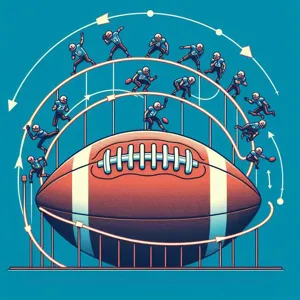American football, a sport that has captivated millions with its thrilling displays of athleticism and strategy, has undergone a remarkable transformation since its inception in the late 19th century.
What began as a rugged and chaotic game, where players often grappled with a simple leather ball—sometimes humorously referred to as the “pigskin”—has evolved into a finely-tuned spectacle characterized by precision plays, advanced tactics, and sophisticated training methodologies. This blog post will take you on a captivating journey through the evolution of American football, exploring its origins, the key innovations that have shaped the game, and the cultural significance it holds in American society today. Join us as we delve into the rich history of this beloved sport, celebrating the milestones and the figures who have contributed to its growth from a rudimentary pastime to a multi-billion-dollar industry that unites fans across the nation.
1. Introduction: A Brief Overview of American Football’s Origins

American football, a beloved sport that captivates millions, has a rich tapestry of origins that intertwine various influences and historical contexts. Emerging in the late 19th century, the game can trace its roots back to the ancient games of rugby and soccer, which were played in England. The early iterations of the sport were chaotic and unregulated, often involving large groups of players and minimal rules, leading to a mix of strategies and styles that were as diverse as the teams themselves.
The first official game of American football took place in 1869 between Princeton and Rutgers, marking a pivotal moment in sports history. This face-off featured a mix of soccer-like kicking and rudimentary handling of the ball, setting the stage for the evolution that would follow. As the sport gained popularity on college campuses, various rule changes were implemented, most notably by Walter Camp, often referred to as the “Father of American Football.” Camp introduced the concept of the line of scrimmage and the system of downs, transforming the game into a more structured and strategic endeavor.
By the early 20th century, American football began to take shape as we know it today, with the establishment of professional leagues and the formalization of rules. The introduction of the forward pass in 1906, a response to the increasing physicality and violence of the sport, opened the door for a more dynamic style of play that emphasized strategy over brute force. This transition marked a turning point, allowing teams to adopt varied offensive strategies and ultimately paving the way for the intricate plays and formations that define the game in the modern era.
As we delve deeper into the evolution of American football, we will explore the pivotal moments, influential figures, and cultural shifts that have shaped this thrilling sport into a cornerstone of American culture, capturing the hearts and minds of fans across the nation. From its rudimentary beginnings to the high-octane spectacle we witness today, the journey of American football is a testament to the enduring spirit of competition and innovation.
2. The Early Days: Rugby and its Influence on Football
The roots of American football can be traced back to the mid-19th century, when the sport was heavily influenced by rugby, a game with deep historical ties to English culture. In the early days, the lines between rugby and football were blurred, as the two sports shared similar principles and objectives. Matches were often chaotic affairs, played on muddy fields with little in the way of standardized rules. Players would pass, kick, and carry a round ball, which was often made from leather, giving rise to the sport’s early nickname: “pigskin.”
Rugby’s influence on American football is evident in the formation of teams, the emphasis on teamwork, and the strategic elements of play. The first official game of American football was played in 1869, between Princeton and Rutgers universities, and it closely resembled rugby, with players allowed to carry the ball but not pass it forward. As the sport evolved, changes began to emerge. The introduction of the line of scrimmage and the forward pass—both revolutionary concepts—marked a significant departure from rugby’s more chaotic style of play.
Marrying elements of both rugby and soccer, early American football was a rough-and-tumble sport that prioritized physicality and endurance. Players donned minimal protective gear, often leading to injuries that would make modern football fans wince. Yet, this raw and unrefined version of the game laid down the groundwork for what would eventually become a distinctly American pastime. As colleges and universities adopted the game, the need for rules and regulations became clear, paving the way for the establishment of governing bodies and the codification of the sport.
The influence of rugby persisted as the game continued to grow in popularity, with many early football players coming from rugby backgrounds. This melding of styles set the stage for the strategic, precision-oriented play we see today, where every pass, tackle, and strategy is meticulously planned and executed. The early days of American football, with their rugged charm and chaotic energy, were crucial in shaping the sport into the highly organized and celebrated phenomenon it has become in contemporary society.
3. The Birth of American Football: Key Historical Milestones

The roots of American football can be traced back to the mid-19th century, where it evolved from a mix of soccer and rugby. The birth of this uniquely American sport is marked by a series of key historical milestones that shaped the game into what we know today.
One of the pivotal moments occurred in 1869, when Princeton and Rutgers faced off in the first intercollegiate football game. This match laid the groundwork for formalized competition and introduced basic rules that would guide the game’s development. While the game resembled modern soccer more than today’s gridiron football, it ignited a passion for team-based, competitive play across college campuses.
In 1876, the formation of the American Football Association brought together various colleges to standardize the rules of the game. This organization made significant changes, including the introduction of the concept of downs—a revolutionary shift that added complexity and strategy to the game. The establishment of these formal rules was critical in shaping American football and differentiating it from its European cousins.
The next significant milestone came in 1880 with the introduction of the forward pass, a game-changer that added an entirely new dynamic to offensive strategies. This innovation was spearheaded by Walter Camp, often referred to as the “Father of American Football.” His contributions included not only the forward pass but also the establishment of the line of scrimmage and the concept of scoring zones, laying the foundation for modern gameplay.
As the sport grew in popularity, so did the establishment of professional leagues. The formation of the National Football League (NFL) in 1920 marked a turning point, elevating the sport’s status and paving the way for the professionalization of the game. With the NFL, American football began to capture the imagination of fans nationwide, leading to the creation of legendary teams and rivalries that still exist today.
These historical milestones serve as a testament to the sport’s evolution, reflecting a blend of innovation, strategy, and cultural significance that has transformed American football into a beloved pastime. As we explore further, it becomes clear that each advancement not only enhanced the gameplay but also solidified the sport’s place in the fabric of American culture.
4. The Introduction of the Forward Pass: Changing the Game
The introduction of the forward pass in American football marked a seismic shift in the dynamics of the game, transforming it from a primarily ground-based contest into a multidimensional aerial battle. Prior to this pivotal change, offenses relied heavily on running plays, with teams engaging in a relentless push to advance the ball through a series of tackles and scrums. The forward pass, famously legalized in 1906 as a means to reduce injuries and promote a more exciting style of play, opened up a whole new realm of strategic possibilities.
Initially met with skepticism and resistance from traditionalists who favored the brute force of rushing plays, the forward pass gradually gained acceptance. Visionary coaches and players began to realize its potential, integrating it into offensive schemes with remarkable creativity. Quarterbacks like John Heisman, after whom the prestigious Heisman Trophy is named, spearheaded these efforts, showcasing the finesse and skill required to execute a successful pass.
As the rule took root, teams began to develop sophisticated passing strategies, with routes and formations designed to exploit defensive weaknesses. By the 1920s, the forward pass was not just a novelty but a cornerstone of the game, fundamentally altering how teams approached scoring and game management. The ability to throw the ball over defensive lines opened up the field, allowing for longer plays and the creation of dynamic offensive units that could stretch the defense in ways previously unimaginable.
This evolution not only changed the tactical landscape of American football but also shaped its cultural identity. The forward pass contributed to the emergence of star quarterbacks, who quickly became the faces of franchises and fan favorites. The excitement generated by soaring passes and incredible catches captivated audiences, drawing larger crowds to stadiums and turning games into highly anticipated events.
Today, the forward pass is an indispensable aspect of American football, celebrated for its artistry and athleticism. It has paved the way for record-setting performances and has become a crucial element of both college and professional football, illustrating how a single rule change can reverberate through the annals of sports history, forever altering the trajectory of a beloved American pastime.
5. The Role of the NFL: Establishing Professional Standards

The National Football League (NFL) has been a pivotal force in shaping American football into the highly organized and commercially successful sport we see today. Established in 1920, the NFL brought a level of professionalism and standardization that was previously lacking in the game. Initially, football was a patchwork of rules and styles, varying greatly from one region to another. The NFL stepped in to create a unified framework, ensuring consistency in gameplay, player eligibility, and officiating standards.
One of the most significant contributions of the NFL has been the establishment of formal rules that govern the game. The league introduced a comprehensive set of regulations that not only defined how the game should be played but also elevated the overall quality of competition. This standardization helped to enhance the skill level of athletes and contributed to the development of sophisticated strategies that characterize modern football.
Moreover, the NFL has played a crucial role in promoting player safety. Through initiatives aimed at reducing injuries and protecting players on the field, the league has implemented various protocols, including concussion assessments and stricter penalties for dangerous plays. These measures not only safeguard the well-being of athletes but also build public trust in the sport, encouraging more fans to engage with the game.
The NFL’s influence extends beyond the field as well. The league has been instrumental in cultivating a culture of professionalism among players, coaches, and staff. With a focus on training, discipline, and business acumen, the NFL has transformed football into a lucrative career path for many athletes. The league’s commitment to excellence has set a standard that resonates throughout the entire sport, inspiring youth leagues and college programs to adopt similar values.
As the NFL continues to evolve, its impact on American football remains undeniable. By establishing professional standards, the league has not only shaped the way the game is played but has also contributed to its status as a beloved American pastime, capturing the hearts of millions across the nation.
6. Equipment Evolution: From Pigskin to Modern Gear
The evolution of equipment in American football is a fascinating journey that reflects both technological advancements and a deeper understanding of player safety. In the early days of the sport, the use of a simple, leather pigskin ball epitomized the rugged, unrefined nature of the game. These early footballs, often hand-stitched and made from tanned hides, were not only difficult to throw but also susceptible to wear and weather conditions. Players relied on sheer strength and raw talent, often playing with minimal protective gear, which resulted in an increased risk of injury.
As the game gained popularity, so too did the need for more sophisticated equipment. The introduction of the forward pass in the early 20th century necessitated a more aerodynamic football design, leading to the modern oblong shape we recognize today. With this shift, manufacturers began to experiment with different materials, ultimately incorporating synthetic leathers and rubber to enhance durability and grip.
Simultaneously, protective gear underwent a profound transformation. Early players donned little more than a simple leather helmet, providing minimal protection against the ferocity of the game. Today, helmets are equipped with advanced padding systems, faceguards, and impact-absorbing materials that significantly reduce the risk of concussions and other head injuries. Shoulder pads have also evolved, becoming lighter and more ergonomic, allowing players to maintain their agility while safeguarding themselves against the physicality of tackles and collisions.
Footwear has not been left out of this evolution either. The classic leather cleats have given way to high-tech designs that offer superior traction and support, tailored to the specific needs of various playing positions. These innovations ensure that players can maintain their footing on the field, whether navigating muddy conditions or making sharp cuts at high speeds.
The journey from pigskin to precision play illustrates not just the growth of American football as a sport, but also the commitment to player safety and performance enhancement. As technology continues to advance, one can only imagine how equipment will evolve further, shaping the future of the game while honoring its rich history.
7. The Impact of Television: Transforming Fan Engagement

The advent of television has indelibly transformed American football, turning it from a regional pastime into a national obsession. When games first began airing in the late 1930s, few could have predicted the seismic shift that would follow. The ability to watch games from the comfort of home revolutionized how fans engaged with the sport, making it accessible to millions who may never have set foot in a stadium.
As broadcasts became more sophisticated, so too did the presentation of the game. Instant replays emerged, allowing fans to relive key moments from multiple angles, while commentators provided insights that deepened the viewer’s understanding of strategies and player dynamics. The introduction of graphics and statistics on-screen further enhanced the viewing experience, immersing fans in the action like never before.
Television also catalyzed the rise of fan culture. Sunday afternoons became sacred, with families and friends gathering around their screens, donning team colors, and sharing in the highs and lows of each game. Tailgating, once a stadium-only activity, evolved into a ritual that fans now partake in at home, creating a sense of community that transcends geographical boundaries.
Moreover, the lucrative contracts between networks and the NFL have allowed for increased investment in player development, stadium upgrades, and fan engagement initiatives—ensuring that the quality of the game continues to improve alongside its popularity. Social media has further amplified this connection, enabling real-time interaction between fans, players, and teams, fostering a vibrant dialogue that keeps the excitement alive long after the final whistle.
In essence, television has not just changed how fans watch American football; it has redefined what it means to be a fan. The immediacy of coverage, combined with the interactive capabilities of modern technology, has created a dynamic landscape where engagement extends beyond the mere act of watching. Today, fans are not just spectators; they are active participants in the narrative of the game, shaping its culture and future.
8. Strategies and Tactics: The Shift Towards Precision Play
As the game of American football evolved, so too did the strategies and tactics employed by teams, marking a significant shift towards precision play. Gone are the days when brute strength and straightforward plays dominated the field. The modern game now thrives on intricate strategies, emphasizing finesse, agility, and meticulous planning.
Coaches and players have begun to adopt a more analytical approach to the game, utilizing data-driven insights to inform every decision. The rise of advanced statistics has transformed how teams evaluate player performance, game situations, and opponent tendencies. This wealth of information allows coaches to design plays that exploit defensive weaknesses with surgical precision. For instance, the introduction of the West Coast offense, which emphasizes short, quick passes and a focus on timing, exemplifies this trend. By prioritizing precision over power, teams can maintain possession and control the tempo of the game.
Moreover, the advent of technology has further enhanced the emphasis on precision. Video analysis tools enable teams to dissect game footage, honing in on the minutiae of player movements and formations. This level of scrutiny allows players to refine their techniques, ensuring they execute plays with unparalleled accuracy. The integration of wearable technology has become commonplace, with players using devices that monitor their performance metrics in real time, leading to a deeper understanding of their physical capabilities and areas for improvement.
Additionally, the evolution of offensive and defensive schemes has prompted teams to adopt hybrid strategies that capitalize on the strengths of their rosters. The use of motion, pre-snap reads, and mismatches has become commonplace, requiring players to be not only physically gifted but also mentally agile. Quarterbacks must now possess a keen understanding of defensive alignments, making split-second decisions that can change the course of a game.
In essence, the shift towards precision play in American football underscores a broader trend in sports: the importance of strategy, analytics, and innovation. As teams continue to embrace these principles, the game will undoubtedly keep evolving, captivating fans with its blend of athleticism and intellect. This evolution not only enhances the quality of play but also ensures that American football remains a dynamic and compelling sport for generations to come.
9. The Rise of Analytics: Data-Driven Decision Making in Football
In the ever-evolving landscape of American football, one of the most transformative developments in recent years has been the rise of analytics. Gone are the days when gut feelings and traditional scouting were the primary drivers of decision-making on the field. Today, teams are leveraging vast amounts of data to inform every aspect of the game, from player recruitment to in-game strategy. This shift towards data-driven decision-making has fundamentally changed how the game is played and managed.
Analytics in football encompasses a range of metrics, including player performance statistics, game footage analysis, and advanced metrics like Expected Points Added (EPA) and Win Probability. Coaches and general managers now have access to sophisticated tools that allow them to break down player efficiency, assess defensive matchups, and evaluate the effectiveness of specific plays. This comprehensive data allows for a deeper understanding of the game, enabling teams to identify patterns and trends that might go unnoticed through conventional observation.
Moreover, the integration of analytics has led to a significant change in game strategy. Coaches are utilizing data to make more informed decisions about when to go for it on fourth down, how to manage clock situations, and which defensive formations to deploy against specific opponents. This analytical approach not only enhances a team’s chances of winning but also elevates the entertainment value of the game, as fans can engage with a more strategic and nuanced form of football.
The impact of analytics extends beyond the gridiron; it’s also reshaping how teams approach player health and performance. With wearables and tracking technology, teams can monitor players’ physical conditions in real-time, allowing for tailored training regimens and injury prevention strategies. This holistic view of a player’s performance and well-being is revolutionizing how teams build their rosters and maintain their athletes throughout the grueling season.
As the influence of analytics continues to grow, it’s clear that data-driven decision-making is not just a trend—it’s a new era in American football. Teams that embrace this analytical mindset are not only gaining a competitive edge but are also setting the stage for the future of the sport, where every snap, pass, and tackle is informed by a wealth of data and insight. The marriage of technology and tradition promises to keep evolving, ensuring that the game remains as dynamic and captivating as ever.
10. Diversity and Inclusion: Changes in Player Demographics
The landscape of American football has undergone a remarkable transformation over the decades, particularly in terms of player demographics. Once dominated by a narrow representation, the sport has evolved into a vibrant tapestry reflecting the rich diversity of American society. This shift has not only enriched the game itself but has also broadened its appeal and accessibility to a wider audience.
In the early days of professional football, the player pool was predominantly composed of white athletes, often from similar socio-economic backgrounds. However, as the sport gained popularity and the cultural landscape of the United States began to change, the influx of talent from diverse racial and ethnic backgrounds became increasingly evident. The civil rights movement of the 1960s played a crucial role in this transformation, as it challenged systemic barriers and opened doors for African American players, who had long been underrepresented in the league.
Today, players from various racial, ethnic, and cultural backgrounds grace the fields of the NFL and college football, showcasing an array of playing styles and perspectives that enhance the game’s complexity and excitement. This diversification is reflected not only in the demographics of the players but also in the coaching staff and management, leading to a more inclusive environment that values different experiences and insights.
Moreover, the increasing visibility of women in football, both on and off the field, marks another significant change in player demographics. Female participation in the sport is growing, whether through flag football leagues, coaching roles, or even as players in professional leagues like the Women’s Football Alliance. This evolution underscores the importance of inclusion and representation, fostering a culture where everyone can aspire to contribute to the game.
The NFL’s commitment to initiatives promoting diversity, such as the Rooney Rule—which mandates that teams interview minority candidates for head coaching and senior football operation jobs—further highlights the ongoing efforts to create a more equitable environment within the sport. As these changes continue to take root, American football is becoming not just a game of athletic prowess, but a platform for social change and unity, reflecting the diverse fabric of the nation itself.
In summary, the evolution of player demographics in American football is a powerful testament to the sport’s ability to adapt and grow. As it embraces diversity and inclusion, the game not only becomes more representative of the society it entertains but also enriches the experiences of fans and players alike, paving the way for a future where all individuals can find a place in the huddle.
11. The Influence of Rule Changes on Gameplay
The evolution of American football is intrinsically linked to the myriad of rule changes that have shaped the game over the decades. Each alteration, whether it was a tweak to the scoring system or a significant shift in how the game is played, has had profound implications on strategy, player roles, and overall gameplay dynamics.
Take, for instance, the introduction of the forward pass in the early 1900s. This revolutionary rule change transformed the sport from a ground-based struggle dominated by running plays into a more dynamic and exciting aerial contest. Teams began to adopt new offensive strategies, specializing in passing plays that showcased the arm strength and accuracy of quarterbacks, and the agility and speed of wide receivers. This shift not only made the game more entertaining for fans but also opened the door for a new generation of athletes who could excel in these specialized roles.
As the game progressed, further rule changes continued to refine and redefine the gameplay. The establishment of the two-point conversion in 1994 introduced an exhilarating new option for teams after scoring a touchdown, adding an element of strategy and excitement to the game. The introduction of strict penalties for helmet-to-helmet contact and other dangerous hits in recent years illustrates a growing emphasis on player safety, which has inevitably influenced defensive strategies and player behavior on the field.
Moreover, the implementation of instant replay has revolutionized officiating, allowing for more accurate calls and ensuring that critical moments in a game receive the scrutiny they deserve. This has changed not only how teams prepare for games—considering potential challenges—but also how fans experience the game, heightening the drama and tension surrounding pivotal plays.
In essence, rule changes in American football serve as a reflection of the sport’s adaptability and its commitment to both player safety and entertainment. Each adjustment, whether embraced or contested, has played a vital role in shaping the modern game, ensuring that football evolves while maintaining the core elements that have captivated audiences for generations. As we look to the future, one can only imagine what new rules and innovations will emerge to further influence the beautiful chaos that is American football.
12. The Globalization of American Football: Expanding the Fan Base
The globalization of American football has transformed it from a predominantly American pastime into a sport that captivates fans around the world. As the game has evolved, so too has its reach, with leagues and events now attracting international audiences. The introduction of the NFL International Series, which features regular-season games played in cities like London and Mexico City, has been a pivotal step in expanding the sport’s fan base. These games not only showcase the talents of American football players but also serve to foster a deeper appreciation for the sport among diverse audiences.
Social media and digital streaming platforms have further accelerated this globalization, allowing fans from every corner of the globe to engage with their favorite teams and players in real-time. The NFL has made significant strides in creating content that resonates with international fans, such as localized broadcasts and multilingual commentary, making the sport more accessible than ever.
Moreover, the rise of youth leagues and American football academies in countries like Germany, Japan, and Brazil highlights the sport’s growing appeal. Young athletes are increasingly drawn to American football, inspired by the excitement of the game and the possibility of playing at professional levels, including the NFL. This grassroots movement is crucial for sustaining the sport’s growth, as it cultivates a new generation of players and fans who will carry the torch forward.
As American football continues to expand its influence worldwide, it brings a unique blend of athleticism, strategy, and entertainment that resonates with diverse cultures. The future of the game looks bright, with a burgeoning global fan base eager to embrace the thrilling spectacle of American football.
13. The Future of American Football: Trends and Predictions
As we look to the horizon of American football, the future promises a fascinating evolution shaped by advancements in technology, changes in player dynamics, and evolving fan engagement strategies. One of the most significant trends is the integration of cutting-edge technology on and off the field. Wearable devices and biometric sensors are revolutionizing training regimens, allowing coaches and players to analyze performance metrics in real time. This data-driven approach not only enhances player safety by monitoring physical exertion but also optimizes game strategies, leading to a more precise and competitive playing style.
Moreover, the rise of virtual and augmented reality is set to transform how fans experience the game. Imagine donning a VR headset that transports you to the sidelines, where you can watch your favorite players up close during critical moments of the match. Enhanced broadcast technologies, including 360-degree cameras and multi-angle views, are likely to become standard, offering spectators an immersive experience from the comfort of their homes.
Player safety continues to be a top priority, prompting leagues to adopt stricter protocols and innovative protective gear. As research into concussions and long-term health impacts unfolds, expect a greater emphasis on rule changes that prioritize player welfare without compromising the essence of the game. This commitment to safety could reshape play styles and strategies, leading to a more nuanced approach to both offense and defense.
Furthermore, as the demographics of fans evolve, the sport may see a shift in marketing strategies and outreach efforts. Engaging younger audiences through social media platforms and interactive content will be crucial in maintaining the sport’s popularity. Teams and leagues will likely focus on building communities around their brands, fostering loyalty through personalized experiences, merchandise, and digital engagement.
Ultimately, the future of American football is bright, driven by innovation and a deepening connection with fans. As the game continues to evolve, it will be exciting to witness how these trends unfold, shaping not only the way the game is played but also how it is experienced and celebrated across the nation.
14. Conclusion: Reflecting on the Journey from Past to Present
As we conclude our exploration of the evolution of American football, it’s fascinating to reflect on the journey that has transformed this beloved sport from its rudimentary beginnings to the sophisticated spectacle we witness today. The game, which once featured players scrapping for a pigskin ball with little regard for rules or strategy, has morphed into a precise, highly organized competition where every play is meticulously planned and executed.
From the early days of rough-and-tumble college games to the birth of professional leagues and the establishment of the NFL, American football has continually adapted to the cultural and technological changes of society. The introduction of innovations such as the forward pass, video replay, and advanced analytics has not only enhanced the way the game is played but has also enriched the experience for fans, creating a multi-layered narrative that unfolds every season.
Moreover, the sport has become a significant cultural phenomenon, influencing everything from fashion to popular culture, and uniting communities across the nation. The Super Bowl, once just another championship game, has evolved into a national holiday, showcasing not only athletic prowess but also music, advertising, and entertainment in a grand display of American spirit.
As we look to the future, the challenges faced by the sport—ranging from player safety to maintaining its widespread appeal—will undoubtedly shape its next chapter. Yet, the resilience and creativity that have characterized American football throughout its history suggest that this dynamic game will continue to evolve, capturing the hearts of future generations just as it has for over a century. The journey from the past to the present is not just a testament to the sport’s adaptability but a celebration of the community and passion that American football inspires.
15. References and Further Reading: Exploring More on Football’s Evolution
For those eager to delve deeper into the rich tapestry of American football’s history and evolution, a wealth of resources awaits you. Understanding the sport’s journey from its informal origins to the highly strategic and technologically advanced game we see today can be both enlightening and enjoyable. Here are some key references and further reading materials that provide fascinating insights into various aspects of the game.
1. **Books**:
– **”The Evolution of American Football” by John B. McCarthy** offers a comprehensive overview of the sport’s development, detailing pivotal moments and figures that shaped the game.
– **”Football: The First Hundred Years” by John A. F. Kinnaird** takes readers on a journey through the early years of football, exploring how societal changes influenced the game.
2. **Documentaries**:
– *”The last Gladiators”* provides an intimate look at the lives of football players, highlighting the physical and emotional demands of the sport.
– *”A Football Life”* series on NFL Network showcases the careers of some of the most iconic players, coaches, and moments in football history, shedding light on how each individual contributed to the sport’s growth.
3. **Academic Journals**:
– Articles from the *Journal of Sport History* and the *International Journal of the History of Sport* frequently feature in-depth analyses of football’s rules, cultural significance, and its evolution over time.
4. **Websites**:
– The *Pro Football Hall of Fame* website is a treasure trove of historical data, player biographies, and timelines that trace the development of the game.
– The *National Football League’s official site* also provides insights into major rule changes and technological advancements that have influenced the game over the decades.
5. **Podcasts**:
– *The Football History Database Podcast* explores various facets of the sport’s history, featuring interviews with historians and sports analysts who share their expertise on football’s evolution.
By engaging with these resources, you can gain a deeper appreciation for the complexities of American football and how it has morphed into a modern spectacle that captivates millions. Whether you are a casual fan or a dedicated enthusiast, exploring the evolution of football not only enhances your understanding of the game but also connects you to the broader cultural narratives that accompany this beloved American pastime.
In conclusion, the journey of American football from its humble beginnings with a simple pigskin to the highly strategic game we know today is a testament to the sport’s dynamic nature and enduring appeal. Each era has contributed unique innovations and cultural shifts that have shaped the game, reflecting broader societal changes along the way. Whether it’s the introduction of forward passing, the evolution of playbooks, or the embrace of advanced analytics, football continues to captivate fans and players alike. As we look ahead to the future of the sport, we can only imagine how it will evolve further, blending tradition with innovation. We hope this exploration of football’s rich history inspires you to appreciate not just the game itself, but the passion and creativity that have propelled it through the ages. So, next time you watch a game, take a moment to reflect on the incredible journey of American football and the countless stories woven into every touchdown and tackle.






